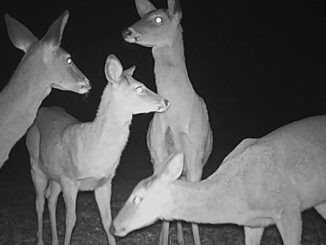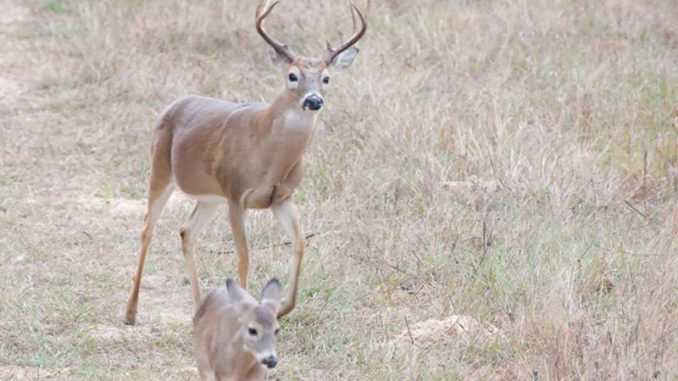
Making mock scrapes is a great way to provoke a dominant buck — and it just might be the tactic that puts a big deer into your crosshairs.
Washington Parish deer hunters Tim Haik and Michael Williams aren’t necessarily control freaks, but there is no doubt both would rather make something happen than sit around waiting for something to happen.
That’s why both men are proponents of using mock scrapes during deer season — and not just during the rut.
Rather than sitting back in their climbers and waiting on a buck to work a scrape line during daylight hours, they dive head first into the middle of that line and do whatever it takes to make that buck think it stands a very good chance of losing all its hot does to a new buck on the block.
Both men have successfully made mock scrapes from Missouri to Alabama, and their curiosity made them start trying the tactic here in Louisiana.
What they found was that Louisiana deer aren’t as different as many people think.
“Mock scrapes definitely work in Louisiana,” Williams said. “I know people say all that crazy stuff they see hunters doing on TV won’t work here, but that’s mainly because they just feel silly trying stuff like that. But the proof is what you throw in the back of your truck after you pull this crazy stuff.”
Making sense of scrapes
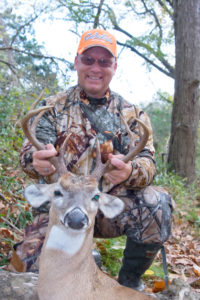
Most deer hunters know the excitement that comes with finding a fresh scrape in the woods, but few of us have given them much thought beyond where to hang our stands.
Understanding why deer make scrapes — and how they use them — will go a long way toward successfully scratching out your own imitations.
Scrapes are typically associated with the rut, but bucks begin their initial scraping activity way before breeding begins.
“Deer use scrapes to communicate,” Williams said. “It’s more of a deer identification system. Deer are naturally curious animals, especially if something is tearing up the dirt or raking back leaves in their woods. When they see a scrape, they’re going to sniff it out.”
They’re also going to know the scent of every local deer in their core area. If a doe comes in and urinates in a scrape, that buck is going to be able to recognize it. Later on during the rut, that buck is going to know if that doe is ready to breed.
“A deer’s sense of smell is its life,” Williams said. “Each one is different. A buck is going to know if another buck comes into its range. They have glands at different parts of their bodies — eyes, base of antlers, back legs — and they use them to leave scent all over a scrape and the branches right above it.”
The devil’s in the details
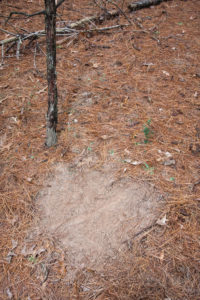
Raking back a pile of leaves or pine straw to expose bare dirt underneath doesn’t seem like it would be all that specialized, but Haik and Williams know there is a bit more to it if they hope for a deer to actually visit the spot they created.
“There’s not much to it, but you’ve got to do it right to attract attention,” Haik said. “I generally take a rake with me to make one, or I just grab a stick in a pinch. I’ve also thrown one of those handheld 3-prong garden cultivators in my bag and use it. Any of it will work to pull the ground cover back.”
After clearing the ground, Haik pulls out his pocket knife and starts shaving off slivers of VS1 estrus scent by ConQuest Scents before smearing it down into the scrape. Then he’ll mark up the surrounding trees with the same scent.
He then goes to work on a fake licking branch right above his fake scrape. Being that he hunts Washington Parish a lot, he typically selects a privet hedge branch and starts to mash it with a pair of pliers.
“I’ll go to town on it pretty good,” Haik said. “Crushing the branch lets it soak up a lot of the scent I put on it. I’ll also pull the branch to rough up the leaves to make it look like a buck has been hooking it a little bit.”
Preorbital gland scent
He’s been experimenting a lot lately with a preorbital gland scent on the licking branch.
“Deer have this gland in the corner of their eyes that has a waxy kind of substance in it that gets on the licking branch,” Haik said. “I found some online — it’s the Smokey’s Deer Lures out of Kentucky. I’ve been trying their forehead gland lure on the licking branch. That scent tells other deer that this is his area.”
And rather than being a miser when it comes to putting out scent, Haik doesn’t think it’s possible to overdo it — the more scent he can put in a mock scrape, the more attractive he feels it will be.
“I’ll even wrap up by pouring some buck urine in the scrape with the doe estrus that’s already there,” he said. “I’m trying to tick off a dominant deer, and all this scent is just the thing to do it.”
While putting out deer scent, Haik takes precautions to reduce or totally eliminate his own. He wears rubber gloves and rubber boots while making a mock scrape, and he sprays down all the tools he uses with scent-killing spray.
Selecting locations
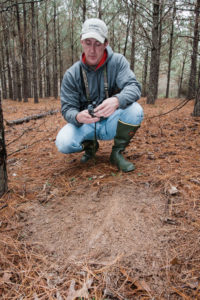
Running out in the woods and making a mock scrape anywhere could very well get the attention of a passing deer, but knowing where to make them is just as important as knowing how to make them.
“If you’re just looking to kill a deer, you can make mock scrapes just about any place on your property that deer use regularly, like the edge of a food plot,” Williams said. “But if you want to kill a big buck, you’ve got to figure out where his core area is and look for a place where you would think there would be a scrape.
“If there’s not one there, make one.”
Some locations where Williams has had success in the past include old logging roads and small ridges. The key to picking the best spot in these larger areas is to locate overhanging limbs that are about antler-high on a mature buck.
Use active scrape line
Perhaps the easiest way to implement mock scrapes on your property is to find an active scrape line — and put a fake one right in the middle of it.
“This works great for making whatever buck is running those scrapes to take notice,” Williams said. “Get in there and make one bigger than all the other ones you see and add a lot of scent to them. When that buck comes back to check his scrapes, he’s going to stumble across the one you made and absolutely tear it up.”
Williams added that the next time you check a mock scrape in the middle of an established scrape line, you’ll more than likely find a huge track right in the middle of the dirt.
That’s as good a sign as any that the buck knows there is an invader in its space, and it’s signalling to the visitor that it’s not at all welcome.
Because he typically bowhunts all season long, Haik prefers to locate his mock scrapes in locations that will bring deer within bow range.
“I’m generally hunting some kind of funnel or travel route,” Haik said, “so I like to make mock scrapes in those kinds of areas. One of the things that seems to work really well is finding a big cow oak dropping acorns within a funnel, or along a trail and making one underneath it.”
Timing mock scrapes
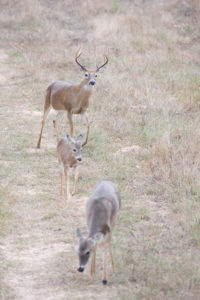
Haik has killed deer over mock scrapes in Washington Parish as early as the first week of November, which might seem a little unusual since the rut doesn’t kick off in that region until late December.
“I put them out early because bucks are ready to breed as soon as they shed their velvet,” Haik said. “I killed an 8-point on Nov. 2 a few years ago that was running to one of my mock scrapes with his nose to the ground like a dog.”
Making a mock scrape before all the local does actually come into estrus seems like a good way of attracting some early attention from a dominant buck. At the very least, your local bucks are going to come investigate an early scrape because they’re ready — even if your local does aren’t.
Williams agreed that getting started early is a good idea.
“Guys check out girls,” he said. “A guy might not be fully interested in a girl for whatever reason, but as soon as he smells that perfume she’s wearing when she walks by, he’s going to pick his head up and take notice. So even if your bucks aren’t fully committed to breeding, they’re still going to check out the smell of a doe.”
Of course, putting out mock scrapes during the peak of the rut should be considered standard practice if you’re going to make some: Just don’t forget about giving them a try early to see what happens.
How to hunt them
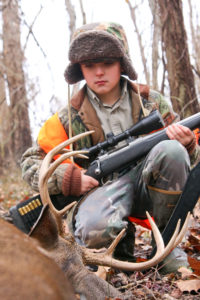
Making a mock scrape and then hanging a stand within sight of it probably isn’t going to give you the results you want.
Rather than hunting near your mock scrape, Williams and Haik recommended backing off of it to the downwind side of deer trails the buck you’re hunting is using to work those scrapes.
Williams even likes to pull out his grunt call when hunting a mock scrape.
“An aggressive buck is not quiet,” he said. “I’ll hit the grunt call a few times because you’ve got to do some stuff out of the ordinary to make him think there is another buck there chasing one of his does. Crashing a few limbs right around you might be good, too. It’s just as good as rattling as long as you don’t make it sound like a stick just broke and fell out of a tree — that’s not going to get his attention. Try to make it sound like the limbs are hitting antlers.”
So if you’re tired of sitting in your stand just hoping a buck walks your way, it’s time to take matters into your own hands with mock scrapes — and make it happen.

